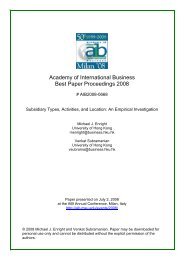AIB 2012 Conference Proceedings - Academy of International ...
AIB 2012 Conference Proceedings - Academy of International ...
AIB 2012 Conference Proceedings - Academy of International ...
You also want an ePaper? Increase the reach of your titles
YUMPU automatically turns print PDFs into web optimized ePapers that Google loves.
SUNDAY<br />
The Impact <strong>of</strong> Emerging Market Firms' <strong>International</strong> Engagement on Product and Process Innovation<br />
Deepak Somaya, University <strong>of</strong> Illinois at Urbana-Champaign<br />
Sandra Corredor , University <strong>of</strong> Illinois at Urbana-Champaign<br />
Bongsun Kim, University <strong>of</strong> Illinois at Urbana-Champaign<br />
Emerging market firms are taking on an increasingly important role in the global economy, both through their<br />
internationalization and contributions to global innovation. However, our understanding about how emerging<br />
market firms' internationalization and innovative performance are related is quite limited. In this paper, we<br />
employ a unique survey <strong>of</strong> firms from ten emerging markets to study the relationship between the "international<br />
engagement" <strong>of</strong> these firms – measured through their exports, imports, competition with foreign firms, foreign<br />
joint ventures, and hiring <strong>of</strong> CEOs with international experience – and their product and process innovation<br />
performance. Our findings are broadly consistent with the idea that experiential and vicarious learning enables<br />
emerging market firms to access different types <strong>of</strong> knowledge through different types <strong>of</strong> international<br />
engagement, leading in turn to different types <strong>of</strong> innovative outcomes. (For more information, please contact:<br />
Deepak Somaya, University <strong>of</strong> Illinois at Urbana-Champaign, USA: dsomaya@illinois.edu)<br />
Emerging Innovation in Emerging Economies: Can Institutional Reforms Help Russia Break Through Its<br />
Historical Barriers<br />
Daniel J. McCarthy, Northeastern University<br />
Sheila M. Puffer, Northeastern University<br />
Loren R. Graham, Harvard University<br />
Daniel M. Satinsky, Russia Innovation Collaborative<br />
The Russian government has embarked upon a national innovation policy and has committed billions <strong>of</strong> dollars<br />
to that effort with the goal <strong>of</strong> developing a knowledge-based economy to enhance participation in the global<br />
arena. Despite many promising initiatives and an abundant supply <strong>of</strong> scientific talent, it is an open question<br />
whether Russia can develop the formal and informal institutions to support sustainable innovation. Historically,<br />
Russia has generally not succeeded with innovation beyond the idea and sometimes product development<br />
stages, with failures attributable to a lack <strong>of</strong> institutions necessary to commercialize the <strong>of</strong>ten breakthrough<br />
technologies and products. This article examines historical examples <strong>of</strong> Russia's attempts at innovation, followed<br />
by a report <strong>of</strong> current innovation initiatives. Both the historical and current initiatives are then analyzed using<br />
institutional theory. The inadequacy <strong>of</strong> formal and informal institutional support has created historical barriers in<br />
Russia, some <strong>of</strong> which are being addressed to develop an innovation ecosystem encompassing a more<br />
supportive institutional infrastructure. The participation <strong>of</strong> international partners increases the chances <strong>of</strong><br />
successful results. The article concludes with implications for shaping national innovation policies in Russia, and<br />
for the roles <strong>of</strong> US firms and universities, as well as other international organizations involved in Russia's<br />
innovation activities. (For more information, please contact: Sheila M. Puffer, Northeastern University, USA:<br />
s.puffer@neu.edu)<br />
Frugal Innovation: What is new<br />
Kazuhiro Asakawa, Keio University<br />
Alvaro Cuervo-Cazurra, Northeastern University<br />
Frugal innovation, innovation that addresses constraints in the environment in which the firm operates, has the<br />
potential <strong>of</strong> improving the poor's lives, creating additional firm, and generating a new international business<br />
research agenda. We propose that, despite recent rhetoric, the concept <strong>of</strong> frugal innovation is not new, but<br />
what is new is the process by which frugal innovations are created in developing countries. In contrast to lavish<br />
innovation in which new technology drives innovation and a new market is created, in frugal innovation the<br />
constraint is the problem that is solved by applying existing technologies in different ways. Additionally, we<br />
provide depth to the concept <strong>of</strong> frugal innovation by introducing three types <strong>of</strong> frugal innovation (input,<br />
throughput and output) and explaining differences in their creation processes. We discuss these ideas by<br />
comparing frugal innovation in Japan after the Second World War with developing countries nowadays. (For<br />
<strong>AIB</strong> <strong>2012</strong> <strong>Conference</strong> <strong>Proceedings</strong><br />
Page 71

















